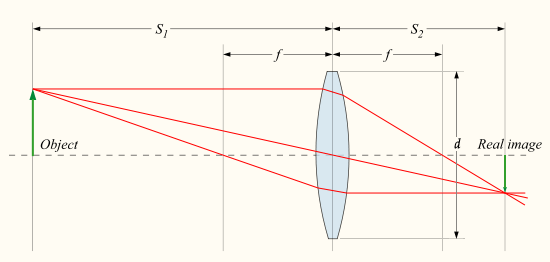In a previous article we looked at how lenses work. We learned about the focal length. Today we’ll focus on camera lenses and what the term f-stop means.
The term f-stop is a ratio. It has no dimensions. You don’t measure an f-stop in meters, inches, kilograms or even degrees Fahrenheit. An f-stop is the ratio of two distances. It’s the ratio of the focal length of a lens to its diameter. In figure 1, the f-stop is f/d _where _f is the focal length and _d _is the diameter.
Why do we care about a lens’s f-stop?
Before we answer this, let’s review how cameras work. A camera uses a lens to focus light on one side of the lens (the outside) onto a film or sensor on the other side of the lens (the inside of the camera). The more light that falls on the film or sensor, the brighter the image will be. Most films or sensors need a certain minimum amount of light in order to take a good picture (one that’s not too dark). If there’s too much light, though, the picture will be too bright.
Now, in photography terminology, the size of the hole that light passes through is known as the aperture. As a simplification, you can think of this as the effective diameter of the lens. In other words, d is the diameter of the aperture. The bigger the aperture, the more light will pass through, and the brighter the picture will be. So you can see why d is important. The bigger the aperture, the less time you need to pass a sufficient amount of light for a good picture.
You can use the bucket analogy: think of the lens as a hole in the bottom of a bucket. If you want to drain the bucketful of water through that hole, the bigger the hole, the less time you need for the bucket to drain.
Another measurement of a lens that’s important is f, the focal length. Lenses with a small focal length are called wide angle lenses — they allow light from a wider angle to pass through the lens and onto the film (or sensor). Lenses with a large focal length are called telephoto lenses — they allow a smaller cone of light into the lens, but the benefit is that picture is bigger (you can see things far away clearly).
So now we can revisit why we should care about a lens’s f-stop. The f-stop is defined as f/d, so if you have two lenses with the same focal length, the one with the smaller f-stop will have a larger aperture - it’s diameter will be larger and it will allow more light through.
Why are advertised f-stops numbered so strangely?
Lenses are circular. The apertures through which light travels are circular. The amount of light that can pass though the lens depends on the area of the circle that defines the aperture. The area of a circle is πr2 where r is the radius, or half of the diameter.
F-stops are defined so that every consecutive f-stop either doubles or halves the amount of light entering the lens. To get area to double or halve at every adjacent f-stop, the ratio of adjacent f-stops need to be the square root of 2 (1.414). A more detailed explanation can be found here.
Why don’t we just use the diameter?
The definition of the f-stop is a way to have different lens manufacturers agree on a standard. Two lenses with an f-stop of 1.4 means the same amount of light can enter the lens, regardless of the focal length of the lens. This also allows for lightmeters to display their results without having to know what lens you’re using to take a picture.
References
- Focal length and F-Stop Explanation
- A Tedious Explanation of the F/Stop
- Plural Posessive of Lens - TheFreeDictionary.com
Licenses
- Figure 1was adapted from
http://en.wikipedia.org/wiki/File:Focal-length.svg and is licensed under the Creative Commons Attribution-ShareAlike-3.0 License.
